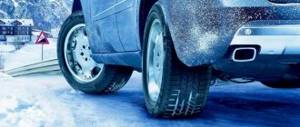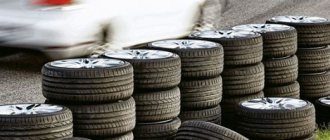How does 2021 legislation regulate tire differentials?
There are 2 legal acts regulating the rules for installing tires on a car:
- Traffic rules and their List of faults (appendix to the Rules) - regulate the conditions when driving a car is prohibited: different tread patterns, different types of tires on different axles of the vehicle and other rules,
- Technical regulations on the safety of wheeled vehicles - this legal act already prescribes regulations for the completeness of vehicles on this issue and concerns more directly the equipment of the vehicle rather than its management.
In our case, the traffic rules will be quite sufficient. This document specifies 2 subtleties of installation:
- different tires on different axles of the car: in front there is a pair of identical tires and in the rear there is a pair identical to each other, but different from those in front,
- unequal tires on the same axle of the car: one on the left, another on the right, front and rear.
But the main subtlety is that the driver is prohibited from operating the car according to traffic regulations. Operation involves driving and controlling the vehicle. Therefore, according to the letter of the law, you can install any combination of tires on your vehicle. It’s just that you are prohibited from driving such a car in certain combinations.
So, let's look at the question of which different tires are not allowed and which ones can be placed on the wheels of a car, and at the end of this article we will provide a summary table.
Why shouldn't you put different tires on your car?
It makes sense to follow the vehicle approval rules regarding the ban on the use of different tires on an axle (as well as a combination of studded and non-studded tires) - not counting the presence of penalties, due to the fact that:
- identical tires on the axle provide better traction;
- identical tires provide smoother and more confident braking;
- The same tires in many cases provide higher vehicle cross-country ability in difficult road conditions.
Please note that the use of different types of tires on different axles may be determined by the design features of a particular vehicle. An elementary example is a tractor whose rear wheels are incomparably larger than the front ones due to the fact that its rear drive bears almost the entire load.
Thus, unless otherwise stipulated by the characteristics and purpose of the vehicle, you should focus on the same tires on all wheels. It is recommended to adhere to this rule at any time of the year: it does not matter whether the machine is operated in winter, summer or in the off-season. In winter, it is certainly desirable to have studs on all wheels. In summer - depending on the type of climate, all wheels must be ready for use in rain or, conversely, in dry conditions.
Different tires on the front and rear axles
Let's look in order at which unequal tires cannot be installed in pairs on the front and, accordingly, rear axles of the car, and then which ones can be installed.
Studded and non-studded tires – not allowed
The combination of winter and summer tires depends on the conditions, how exactly on the axles it is installed, and whether it is studded or not. So:
- You cannot put summer and winter tires on the same axle on the right and left, respectively,
- Traffic regulations also prohibit the installation of a combination of studded and non-studded tires on the entire vehicle.
Thus, you are also prohibited from driving a car if it has at least one summer tire among the winter studded ones, or one studded tire among the summer ones.
You can install:
- summer tires on the front axle, and winter tires on the rear, but only if the winter tires are studless (Velcro),
- similarly, winter non-studded (Velcro) tires on the front, and summer tires on the rear,
- all-season tires with the same combinations.
The combination of studded and non-studded tires is the only prohibition regarding the possibility of installing rubber on different axles of the car (front and rear). The traffic rules do not provide for any other restrictions. In particular, you can put:
- tires from one manufacturer on the front axle, tires from another on the rear axle,
- similarly, dimensions may vary: height, radius and profile,
- tread pattern,
- tube tires and tubeless tires,
- diagonal and radial design.
Installation of different tires on different axles according to traffic regulations
According to traffic rules, it is allowed to put different wheels on a car.
But it is necessary to take into account some features. It is generally not allowed to mount such structures on the all-wheel drive version, as this will disrupt the operation of the drives and transmission. Gearboxes do not operate evenly, which will ensure their rapid wear. It is required to install tires exclusively in pairs. Different tread and rubber composition under the same conditions can behave unpredictably, which greatly increases the danger of driving. For example, friction and studded tires have different braking distances - the car can simply turn around on a slippery surface. The same thing happens in the summer. In the rain there is a high risk of hydroplaning. Thus, the left side holds the road, and the right side already slides through the water, which inevitably ends in a ditch.
Different caliber tires behave in a similar way on snow. Let's assume that there is a friction clutch on the rear axle and a stud on the front. On a slippery section, tires without studs will begin to drift. The result is a U-turn across the road. In the worst case scenario, it might throw you into the oncoming lane and cause an accident.
It is recommended to install two identical pairs of tires. In extreme cases, you can use the spare tire as an emergency method.
Important note!
- This article provides basic information, but each case is different.
- In 92% of all situations there are important nuances that can affect the outcome of the entire case.
- An experienced lawyer will study all the materials of the case and indicate in which direction to move.
Therefore, our website employs on-duty legal consultants who delve into each case and are aimed at solving it.
Ask a Question
or consult toll-free (Moscow), (St. Petersburg), 8 (all of Russia).
Different tires on the same axle: left and right
But here there are much more restrictions. Let's look at them all according to the criteria for tire differences.
Studded and non-studded
- not possible: on one axis and in pairs on different axes,
- you can: only either all studded or all non-studded.
Forbidden! If you have non-studded tires on the left and studded tires on the right, then you will face a fine from the traffic police officer (about its size and nuances below). This applies to both the front and rear axles.
Moreover, as we have already emphasized above, you cannot install
Different winter or summer
- not possible: on one axis,
- possible: in pairs on different axes.
This means if it is summer tires and Velcro instead of studded. In this case, the 2021 traffic regulations also prohibit the installation of such a tire combination.
Tires of different manufacturers or models
- not possible: on one axis,
- possible: in pairs on different axes.
The rules stipulate that either the front or rear tire models must not be different. It follows that manufacturers should not differ either. If, for example, Nokian Hakkapeliitta 3 tires are used on the left, then on the right you cannot install not only any Michelin X-Ice, but even another model from the same manufacturer - for example, Nokian Hakkapeliitta 2 or 4.
Different sizes: radius, width and profile
- not possible: on one axis,
- possible: in pairs on different axes.
The legislation does not directly describe exactly what technical parameters should be the same for rubber symmetrically located on the same axis. But he emphasizes that it is prohibited to install tires of different sizes. But the dimensions, logically, include the profile, the width, and the same radius. Therefore, such tires cannot be used on one axle. But on different axes in pairs - it’s possible.
With different tread patterns
- not possible: on one axis,
- possible: in pairs on different axes.
Obviously, a different pattern means that you have tires of different models and perhaps even manufacturers. This is prohibited under the 2021 traffic rules.
But even if somehow it turns out that the models coincide, the Rules still directly prohibit the installation of tires with different tread patterns on the wheels of a car.
With different tread wear
- possible: on one axis, but with two subtleties,
- possible: in pairs on different axes.
So, the Road Traffic Rules do not directly prohibit the use of tires with different wear. But there are 2 things that are specified in the conditions under which it is prohibited to drive on different tires:
- if there is a new tire on the left and a retreaded one on the right, and vice versa,
- if on the left there is a new tire, and on the right - with an in-depth pattern, and vice versa.
Please note that this only applies to installing tires on one axle. You can bet such combinations on different pairs.
Tube and tubeless
- not possible: on one axis,
- possible: in pairs on different axes.
Something that may surprise many drivers. In fact, you are prohibited from placing a tire with a tube on one side and a tubeless tire on the other. Unexpectedly, but this is the letter of the law!
Is it possible to put tires with different wear on one axle?
Only identical tires should be installed on one axle of a car..
Different tires cannot be used on the same axle, but tires with different wear on the same axle are not subject to restrictions.
If your vehicle has damaged two left wheels, then you can install the remaining right tires on one of the axles, and a pair of new tires on the other axle.
The ban applies to the use of new and retreaded tires, as well as new tires and tires with a deep tread pattern:
- Retreaded tires are when a completely worn tire is sent to a factory and has a new layer of rubber and tread applied to it.
- Deepening the tread pattern is when, using special equipment, the grooves on the tire are deepened, that is, a new tread is cut out.
Such deepened and retreaded tires cannot be used simultaneously with new ones.
By not following traffic rules, a driver can cause damage not only to himself and his vehicle, but also to others. As a result of improper operation of the car, your own health may suffer, on which it is better not to skimp.
Video: Different tires on a car will result in a fine
What about the spare tire?
And with it everything is quite simple - it is not installed on the car, and the Basic Provisions of the Traffic Regulations regulate restrictions only on the installed wheels. Therefore, the spare tire may differ from the tires on the car in absolutely all of the above parameters.
But from here an important “but” becomes obvious - this concerns the inspection by the traffic police inspector of it, which is in the trunk. If you puncture a tire and put a spare tire in its place, then an offense will be created if the tires become different in one of the prohibited combinations listed above.
Which axle should I put the best tires on?
Tires on a car often wear unevenly. For example, a car with front-wheel drive “eats” the tires in front faster. On the rear drive axle it is the other way around.
Some car enthusiasts buy new wheels and put them on the drive axle, where there is intense abrasion, and leave the second part unchanged. According to the rules, this is not prohibited and the logic can be traced. Rowing wheels require more traction than coasting wheels.
The exception is vehicles with all-wheel drive. Here the wear is more uniform, and it is recommended to change the tires as a set at once.
What else is not allowed for tires and wheels?
Traffic regulations stipulate not only different tires in the form of their established combinations, but also other requirements for each of them. Among them:
- residual tread depth when summer tires wear out – at least 1.6 mm (for passenger cars),
- residual tread depth when wearing winter tires (studded or non-studded - it doesn’t matter) - at least 4 mm (for passenger cars),
- if there are cuts or tears on the tire, provided that the cord is visible from them (nylon on the side or metal on the tread - it doesn’t matter),
- if the tire tread has peeled off from the sidewall,
- if the tires have a load rating that is different from what is allowed for your car,
- if the tire sizes are not provided for by the design of the car (the inspector can check this and compare it on the plate on the side of the door or inside the gas tank cap with the recommended tire pressure),
- if the disks are missing at least one bolt/nut, and also if the mounting holes are worn out or damaged, or if the disks themselves are damaged (chips, cracks).
What is the fine for different tires?
For any violations of the List of Faults as an appendix to the Traffic Regulations, the Code of Administrative Offenses valid for 2021 provides for a fine of 500 rubles or a warning. This is provided for in Part 1 of Article 12.5 of the Code. It prescribes a single fine specifically for violations of the Basic Provisions of Traffic Regulations - any conditions and malfunctions under which it is prohibited to drive a car.
In rare cases, the traffic police inspector may also issue a requirement to eliminate the conditions leading to the offense and show the car to the traffic police within 10 days with the fault corrected (with the same tires, if different, this is a violation of the Rules). Otherwise, according to the employee’s report, the car’s registration is canceled, and then the license plates will be put on the wanted list, and the very first stop by another traffic police officer will then lead to a impound lot and the confiscation of license plates and registration certificates.
But let us repeat, this happens very rarely, and most often the requirements are issued for tinting, excessive tuning (sports muffler, etc.), or if you installed completely different wheels - for example, you made a “bigfoot” out of a car.
Finally, we note that the restriction on the use of different tires is expressed in a specific paragraph of the traffic rules - 5.5 of the List of faults.








